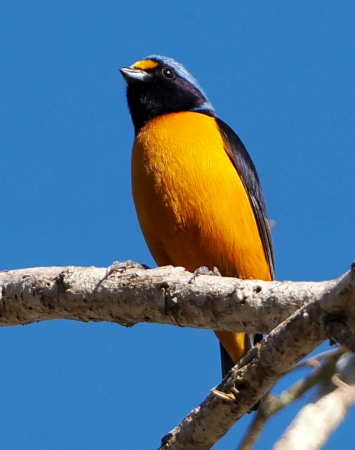
Get out your binoculars and plan a Caribbean birding adventure because we’ve got five new species of birds for you!
The American Ornithological Society has just announced their 64th Supplement to the Checklist of North American Birds. Every year, ornithologists and birders alike eagerly peruse their current bird lists and wait for the announcement of new bird species! Usually, these new species don’t arise from a remote jungle expedition, but by re-examining the differences and similarities within our current species lists.
Species can either be “lumped” or “split.” Lumps occur when two similar species are lumped back together and considered one species again. This is usually the case for very similar birds that have overlapping ranges. “Splits” are when one species is divided into two or more different species. These splits usually include birds that may look alike but evidence suggests have diverged sufficiently that their populations would no longer interbreed.
We are very excited to welcome these new bird species to the Caribbean—bringing us now to a total of 180 endemic bird species. Our Caribbean birding hotspot just got even hotter, giving you all the more reason to plan your next Caribbean birding adventure!
The joys of isolation…
Within the Caribbean, we have many species that occur across multiple islands, but don’t island hop–making these isolated populations. Over time, as these bird populations continue to breed in isolation from one another, they can develop differences, and even evolve into distinct species! By reviewing evidence, including genetics, morphology, plumage, vocalizations, and behaviors; ornithologists can determine if the populations are in fact distinct enough to be considered different species.
This year we are very excited to announce that we have five new species for the Caribbean! These species all fall under the category of splits (there were 4), meaning they were formerly considered one species and are now considered two or more! Let’s review the newest members of the flock.
*Drum roll*…welcoming five new Caribbean species!
Grand Cayman Bullfinch and Cuban Bullfinch
Let’s give a warm welcome to a new bullfinch species in the Caribbean, the Grand Cayman Bullfinch (Melopyrrha taylori)! This species was split from the Cuban Bullfinch (Melopyrrha nigra) due to vocal and morphological differences. The Cuban Bullfinch can now proudly boast that it is a true Cuban endemic, and the Grand Cayman islands have their second endemic bird species. Interestingly, the research supporting the split came from a birdwatcher’s observations of song differences between birds on Cuba and Grand Cayman! This show the value of citizen scientist birders being observant and uploading their information to apps like eBird (sightings, photos, and recordings of songs and calls).
Hispaniolan Nightjar and Cuban Nightjar
Let’s give a warm welcome to two new species of nightjar! The bird formerly known as the Greater Antillean Nightjar (Antrostomus cubanensis) has now been split into the Hispaniolan Nightjar (Antrostomus ekmani) and Cuban Nightjar (Antrostomus cubanensis), based on convincing vocal differences between the two populations. The Hispaniolan Nightjar is found in the western third of the Dominican Republic and the western part of the Tiburon Peninsula of Haiti. The Cuban Nightjar is found throughout the island of Cuba.
Listen to the difference in the songs of the Hispaniolan Nightjar and Cuban Nightjar!
From one to three new Euphonias! Puerto Rican, Hispaniolan, and Lesser Antillean
Let’s give a warm welcome to not two but three new Euphonia species! The former Antillean Euphonia (Chlorophonia musica) has now been differentiated as the Puerto Rican Euphonia (Chlorophonia sclateri), the Hispaniolan Euphonia (Chlorophonia musica), and the Lesser Antillean Euphonia (Chlorophonia flavifrons). This long awaited split is based on considerable plumage differences between the three new species.
Males of the Hispaniolan Euphonia and Puerto Rican Euphonia have a turquoise blue crown and nape, blackish-violet face, back and wings, a small band of tawny-yellow to orange on the forehead. However, the male Puerto Rican Euphonia boasts a sunny yellow throat, underside, and rump, while the male Hispaniolan Euphonia has a dark blue throat and orange underside and rump. The male Lesser Antillean Euphonia has an olive-green body, sky-blue crown and nape, and yellow forehead; his plumage is fairly similar to the females of all three species but he is a little brighter.
The females of all three species are lighter overall, with yellow-greenish body and wings, turquoise crown and nape, and the forehead nicely adorned with a spot of gold.
Hispaniolan Palm-Crow and Cuban Palm-Crow
Let’s give a warm welcome to two new species of palm crow! The bird formerly known as the Palm Crow (Corvus palmarum) is now recognized as the Hispaniolan Palm-Crow (Corvus palmarum) and the Cuban Palm-Crow (Corvus minutus). The vocalizations between the two are quite distinct, enough that ornithologists can tell the two apart, so it’s likely that the crows can too! They also show genetic and behavioral differences, including a curious tail-flicking behavior exhibited only by the Hispaniolan Palm-Crow!
Listen to the differences between the calls of the Hispaniolan Palm-Crow and Cuban Palm-Crow.
We are very excited to welcome these new bird species to the Caribbean—bringing us now to a total of 180 endemic bird species. Our Caribbean birding hotspot just got even hotter, giving you all the more reason to plan your next Caribbean birding adventure!
We’re curious: Did you get an “armchair lifer” or two? (i.e., a new bird on your life list without actually having seen a new bird due to splits like this) Which of these new species would you like to see the most? Comment below!













One comment
Comments are closed.